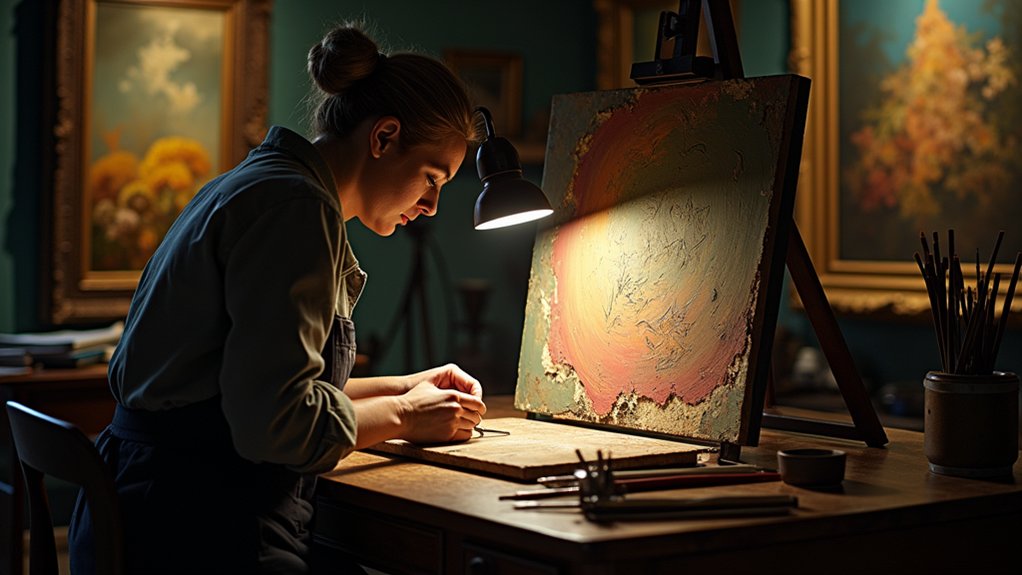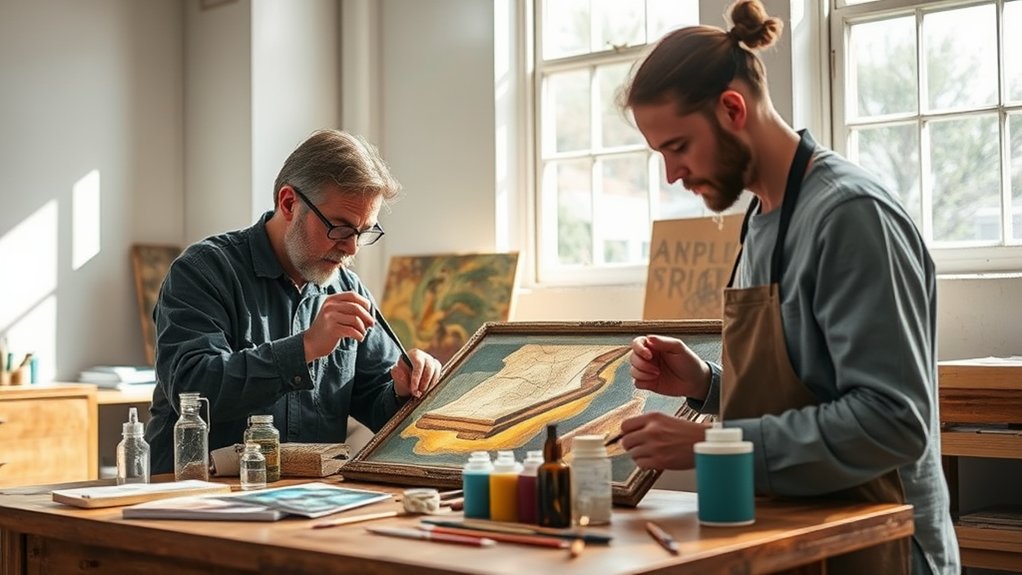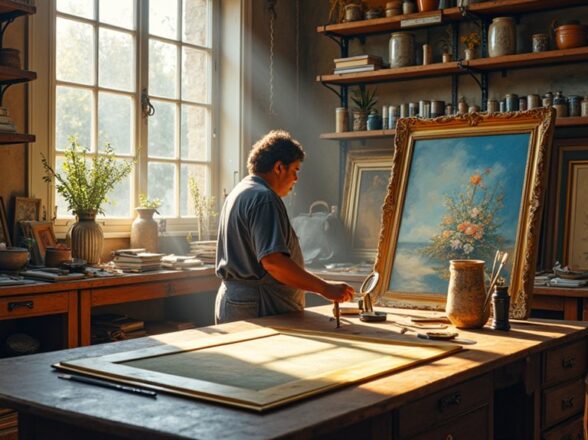What’s the Difference Between Art Restoration and Conservation? When to Restore vs. Preserve

Art restoration aims to bring artwork back to its original state, often altering historical markers, while conservation focuses on stabilizing and preserving the current condition of the piece. Conservation values the original material and historical integrity, using reversible techniques, whereas restoration frequently involves irreversible methods. Choosing between the two depends on factors like the artwork's age, significance, and damage extent. If an artwork is culturally important, conserving it might be prioritized. Each approach requires specialized training and expertise to avoid damage. Understanding these differences helps in making informed decisions about how to treat artworks moving forward.
Understanding Art Conservation

Although you might think of art conservation as simply fixing damaged pieces, it's actually a complex field that blends art, history, and science. Art conservation and restoration focus on stabilizing and preserving artworks in their current form. Specialists use high-tech methods like temperature control and moisture monitoring to prevent further damage. The philosophy of conservation emphasizes maintaining the original state of the artwork while preserving its historical integrity. This means making minimal irreversible changes during the process. Reversible techniques are preferred, allowing for future analysis and adaptability. Conservation also values patina and surface wear because these features tell stories about the object's history and significance. Understanding these principles is essential for anyone interested in preserving our cultural heritage.
Exploring Art Restoration
While art conservation focuses on preserving the original state of a piece, art restoration aims to return it to its former glory, often disregarding historical modifications. Restoration involves altering the artwork, which can erase important historical markers. Decisions on whether to restore an artwork depend on factors like age, ownership, and significance. Proper training is essential for restorers, as improper methods may lead to irreversible damage. While restoration enhances the visual impact of a piece, it may compromise its historical integrity.
| Aspect | Description |
|---|---|
| Purpose | Return artwork to original state |
| Considerations | Age, ownership, significance |
| Risks | Potential loss of authenticity |
| Professional role | Trained experts to avoid irreversible damage |
Key Differences Explained

When it comes to art conservation and restoration, the goals and methods used can differ greatly. Conservation aims to keep an artwork in its current state, while restoration seeks to make it look as it did when it was first created. Understanding these key differences helps you appreciate the historical integrity of the artwork and the techniques involved in each process.
Conservation vs. Restoration Goals
Understanding the goals of art conservation and restoration is essential for appreciating their distinct roles in preserving cultural heritage. Conservation focuses on maintaining an artwork's current state and preventing further damage. It emphasizes the historical integrity of the piece, using reversible techniques to guarantee any changes can be undone. On the other hand, art restoration aims to return the artwork to its original appearance. This often involves altering materials, which can compromise the artwork's provenance. The choice between conservation and restoration depends on factors like the artwork's age, importance, ownership, and extent of damage. While both fields require specialized training, the methods and goals differ considerably, reflecting their unique contributions to preserving art.
Techniques and Materials Used
Art conservation and restoration employ distinctly different techniques and materials, each tailored to their unique objectives. Conservation focuses on reversible methods, using materials like wheat starch paste for paper repairs. This guarantees future treatments can be applied without damaging the original artwork. In contrast, restoration may use irreversible methods that alter the artwork's components, potentially compromising its historical integrity. Art conservators select materials based on their compatibility with the original artwork, prioritizing preservation over alteration. Restorers, however, might use modern paints that replicate original appearances but do not match historical compositions. High-tech conservation practices include climate control and light management, while restoration often emphasizes aesthetic improvements without considering long-term stability.
Historical Integrity Considerations
While both conservation and restoration aim to address the needs of artworks, they approach historical integrity in fundamentally different ways. Conservation focuses on preserving the current state of historical artifacts, maintaining their patina and markers of age. In contrast, art restorers often recreate an artwork's original appearance, which can lead to irreversible changes.
| Aspect | Conservation | Restoration |
|---|---|---|
| Focus | Preserve current condition | Recreate original appearance |
| Methods | Emphasizes reversible techniques | Often involves irreversible changes |
| Impact on Integrity | Maintains historical markers | May disregard historical context |
Your choice between these approaches should consider the artwork's significance and condition. Balancing these factors guarantees respect for the historical integrity of the piece.
Training and Certification Insights
When pursuing a career in art conservation or restoration, the path to expertise often diverges markedly. As an art conservator, you'll typically need rigorous training, including a Master's degree in Conservation. This education includes specialized coursework in art, history, and chemistry. The American Institute for Conservation sets standards to guarantee you learn effective techniques. In contrast, restoration training often relies on apprenticeships, leading to varied skill levels.
Here are some key aspects to reflect on:
- Master's degree in Conservation
- Specialized coursework requirements
- Hands-on apprenticeship hours (400 to 4,000)
- Importance of a thorough portfolio
- Standards set by professional organizations
Understanding these elements is essential for your career in conservation or restoration.
Notable Projects in Preservation

In the domain of preservation, notable projects highlight the dedication and skill involved in conserving cultural heritage. The National Gallery of Art has completed in situ conservation projects for 17th and 18th-century marble sculptures, emphasizing the need to maintain works of art in their original locations. However, conservation isn’t always successful; a famous case involved an amateur painter altering a fresco of Jesus, leading to irreversible damage. Major museums frequently conduct large-scale conservation initiatives, showcasing their commitment to preserving collections. These projects often engage the public through demonstrations and workshops, raising awareness of art preservation efforts. Furthermore, conservation reveals the complex histories behind artworks, enriching their cultural significance and enhancing our understanding of the past. Additionally, the process of conservation is intertwined with logistical challenges, such as ensuring the safe transport of artworks to and from conservation facilities. Fine art transportation services play a crucial role in protecting these valuable pieces during their journey, minimizing risks associated with handling and movement. As institutions invest in both conservation and transportation, the art world moves closer to safeguarding its heritage for future generations to appreciate and learn from. In light of these challenges, it becomes imperative for institutions and collectors to understand how to choose art restoration services that are not only skilled but also ethically responsible. Selecting the right professionals ensures that the integrity of the artwork is maintained while addressing any deterioration or damage. With a multitude of options available, thorough research and consultations are essential in finding reputable specialists who align with the specific needs of the artwork, ultimately ensuring its preservation for future enjoyment and education.
Factors in Decision-Making
When deciding between restoration and conservation, you'll want to contemplate several key factors. Evaluating the historical significance of the artwork helps determine whether to preserve its integrity or enhance its appearance. You should also assess the condition of the piece, as fragile items often require conservation to avoid further damage. Additionally, consider using climate-controlled storage options to protect sensitive items, ensuring their preservation during conservation processes.
Historical Significance Assessment
Evaluating the historical significance of an artwork is essential in determining whether to restore or conserve it. You should consider several factors that influence this decision:
- The context of the artwork's creation
- Its importance in art history
- The ownership and its impact on decision-making
- Historical alterations and their relevance
- Documentation of the artwork's provenance
Each of these elements helps clarify whether restoration or conservation is more appropriate. For highly fragile pieces, conservation may be best to avoid irreversible changes. In contrast, if the historical significance is enhanced by restoration, that option might be more fitting. Understanding these factors guides you in making informed decisions about the artwork's future and its preservation for generations to come.
Condition Evaluation Criteria
Understanding historical significance lays the groundwork for evaluating an artwork's condition. Condition evaluation involves examining the current state of the artwork, including any damage and deterioration. Key factors in this process include the material composition, age, and extent of damage. These factors help determine whether art conservation or restoring paintings is more appropriate. The historical significance of the piece often influences decision-making, with culturally important artworks prioritized for preservation. Additionally, it's vital to reflect on the potential impact of restoration techniques on the original materials, as irreversible changes can compromise authenticity. Consultation with trained conservators and restorers is essential, as they provide valuable expertise on the best approach based on the artwork's specific condition and preservation goals.
Ownership and Display Factors
Ownership and display factors play a pivotal role in determining the best approach to art restoration or conservation. As an owner, your priorities influence decisions about an artwork's fate.
- Private collectors may focus on aesthetics.
- Museums often prioritize historical integrity.
- Environmental conditions can dictate conservation needs.
- The artwork's historical significance influences whether to restore or conserve.
- Consulting specialists guarantees the chosen method aligns with best practices.
For severely deteriorated pieces, restoration may be necessary to make them presentable. In contrast, well-preserved items typically require conservation to maintain their state. Understanding ownership and display factors helps you make informed choices about your artwork's future, balancing personal desires with preservation needs.
Frequently Asked Questions
What Is the Difference Between Preservation, Conservation, and Restoration of Art?
When you explore art techniques, you'll notice preservation focuses on stability, conservation prioritizes ethical considerations and historical significance, while restoration aims for aesthetic recovery, often risking irreversible changes that can affect a piece's integrity.
Is Preserve and Restore the Same Thing?
Preserving art is like keeping a cherished memory alive, while restoring it can reshape that memory. When you consider methods comparison and ethical considerations, remember that preserve and restore serve distinct purposes in art treatment.
What Is the Difference Between Preservation and Conservation?
Preservation focuses on maintaining art integrity through preventive measures, while conservation involves ethical considerations and techniques to address existing damage. Understanding their roles is essential for respecting historical significance and ensuring artifacts' longevity for future generations.
What Is the Conservation and Preservation of Art?
Think of art conservation as a guardian angel, protecting artworks. You'll explore art materials, historical significance, and ethical considerations, ensuring their stories remain intact while preventing deterioration and respecting their original essence for future generations.
Conclusion
In conclusion, art restoration and conservation serve distinct purposes in preserving cultural heritage. Restoration aims to return an artwork to its original state, while conservation focuses on maintaining its current condition. As the saying goes, "An ounce of prevention is worth a pound of cure." Understanding when to restore versus when to preserve is vital. By making informed decisions, you help guarantee that art remains intact for future generations. Both practices are essential for safeguarding our artistic history.
Related posts
Recent posts
Post Categories
Tags
Subscribe




